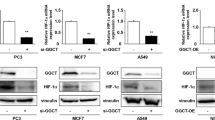Abstract
Hydrogen sulfide (H2S), an endogenous signaling molecule in mammalian cells, shows a variety of biological effects. Cystathionine γ-lyase (CSE) is a key enzyme in the trans-sulfuration pathway responsible for the production of endogenous H2S. Whether CSE expression is regulated by hypoxia in mammalian cells remains largely unknown. This study revealed that these regulatory effects changed with time at transcriptional and post-transcriptional levels. Hypoxia regulated CSE expression in mammalian cells in a complex manner; CSE transcription went through a down-regulation and recovery period, while CSE mRNA and protein levels increased during hypoxia. Taken together, the results suggest that CSE can respond to hypoxia through transcriptional and post-transcriptional regulation, and CSE expression can be up-regulated by hypoxia to a certain extent. Therefore, the up-regulation of CSE expression during hypoxia may be useful for increasing the production and concentration of H2S in mammalian cells and indirectly protecting cells from hypoxia.



Similar content being viewed by others
References
Abe K, Kimura H (1996) The possible role of hydrogen sulfide as an endogenous neuromodulator. J Neurosci 16:1066–1071
Blackstone E, Roth MB (2007) Suspended animation-like state protects mice from lethal hypoxia. Shock 27:370–372
Blackstone E, Morrison M, Roth MB (2005) H2S induces a suspended animation-like state in mice. Science 308:518
Dombkowski RA, Doellman MM, Head SK, Olson KR (2006) Hydrogen sulfide mediates hypoxia-induced relaxation of trout urinary bladder smooth muscle. J Exp Biol 209:3234–3240
Dombkowski RA, Naylor MG, Shoemaker E, Smith M, DeLeon ER, Stoy GF, Gao Y, Olson KR (2011) Hydrogen sulfide (H2S) and hypoxia inhibit salmonid gastrointestinal motility: evidence for H2S as an oxygen sensor. J Exp Biol 214:4030–4040
Dominy JE, Stipanuk MH (2004) New roles for cysteine and transsulfuration enzymes: production of H2S, a neuromodulator and smooth muscle relaxant. Nutr Rev 62:348–353
Gadalla MM, Snyder SH (2010) Hydrogen sulfide as a gasotransmitter. J Neurochem 113:14–26
Hosoki R, Matsuki N, Kimura H (1997) The possible role of hydrogen sulfide as an endogenous smooth muscle relaxant in synergy with nitric oxide. Biochem Biophys Res Commun 237:527–531
Kimura H (2002) Hydrogen sulfide as a neuromodulator. Mol Neurobiol 26:13–19
Kimura H (2011a) Hydrogen sulfide: its production and functions. Exp Physiol 96:833–835
Kimura H (2011b) Hydrogen sulfide: its production, release and functions. Amino Acids 41:113–121
Madden JA, Ahlf SB, Dantuma MW, Olson KR, Roerig DL (2012) Precursors and inhibitors of hydrogen sulfide synthesis affect acute hypoxic pulmonary vasoconstriction in the intact lung. J Appl Physiol 112:411–418
Makarenko VV, Nanduri J, Raghuraman G, Fox AP, Gadalla MM, Kumar GK, Snyder SH, Prabhakar NR (2012) Endogenous H2S is required for hypoxic sensing by carotid body glomus cells. Am J Physiol Cell Physiol 303(9):C916–C923
Olson KR (2008) Hydrogen sulfide and oxygen sensing: implications in cardiorespiratory control. J Exp Biol 211:2727–2734
Olson KR, Perry SF (2010) H2S and O2 sensing. Proc Natl Acad Sci USA 107:E141
Olson KR, Whitfield NL (2010) Hydrogen sulfide and oxygen sensing in the cardiovascular system. Antioxid Redox Signal 12:1219–1234
Olson KR, Dombkowski RA, Russell MJ, Doellman MM, Head SK, Whitfield NL, Madden JA (2006) Hydrogen sulfide as an oxygen sensor/transducer in vertebrate hypoxic vasoconstriction and hypoxic vasodilation. J Exp Biol 209:4011–4023
Olson KR, Healy MJ, Qin Z, Skovgaard N, Vulesevic B, Duff DW, Whitfield NL, Yang G, Wang R, Perry SF (2008) Hydrogen sulfide as an oxygen sensor in trout gill chemoreceptors. Am J Physiol Regul Integr Comp Physiol 295:R669–R680
Peng YJ, Nanduri J, Raghuraman G, Souvannakitti D, Gadalla MM, Kumar GK, Snyder SH, Prabhakar NR (2010) H2S mediates O2 sensing in the carotid body. Proc Natl Acad Sci USA 107:10719–10724
Schmittgen TD, Livak KJ (2008) Analyzing real-time PCR data by the comparative CT method. Nat Protoc 3:1101–1108
Takemura G, Ohno M, Fujiwara H (1997) Ischemic heart disease and apoptosis. Rinsho Byori 45:606–613
Wang Q, Liu HR, Mu Q, Rose P, Zhu YZ (2009) S-propargyl-cysteine protects both adult rat hearts and neonatal cardiomyocytes from ischemia/hypoxia injury: the contribution of the hydrogen sulfide-mediated pathway. J Cardiovasc Pharmacol 54:139–146
Wang R (2010) Hydrogen sulfide: the third gasotransmitter in biology and medicine. Antioxid Redox Signal 12:1061–1064
Xu GY, Winston JH, Shenoy M, Zhou S, Chen JD, Pasricha PJ (2009) The endogenous hydrogen sulfide producing enzyme cystathionine-beta synthase contributes to visceral hypersensitivity in a rat model of irritable bowel syndrome. Mol Pain 5:44
Yang C, Yang Z, Zhang M, Dong Q, Wang X, Lan A, Zeng F, Chen P, Wang C, Feng J (2011) Hydrogen sulfide protects against chemical hypoxia-induced cytotoxicity and inflammation in HaCaT cells through inhibition of ROS/NF-kappaB/COX-2 pathway. PLoS One 6:e21971
Yao LL, Huang XW, Wang YG, Cao YX, Zhang CC, Zhu YC (2010) Hydrogen sulfide protects cardiomyocytes from hypoxia/reoxygenation-induced apoptosis by preventing GSK-3beta-dependent opening of mPTP. Am J Physiol Heart Circ Physiol 298:H1310–H1319
Acknowledgments
This work was supported by the National Basic Research Program of China (973 Program, No. 2010CB912604).
Author information
Authors and Affiliations
Corresponding author
Rights and permissions
About this article
Cite this article
Wang, M., Guo, Z. & Wang, S. Regulation of Cystathionine γ-Lyase in Mammalian Cells by Hypoxia. Biochem Genet 52, 29–37 (2014). https://doi.org/10.1007/s10528-013-9624-7
Received:
Accepted:
Published:
Issue Date:
DOI: https://doi.org/10.1007/s10528-013-9624-7




